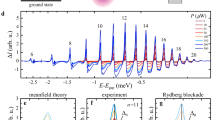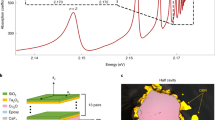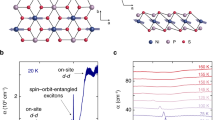Abstract
A highly excited atom having an electron that has moved into a level with large principal quantum number is a hydrogen-like object, termed a Rydberg atom. The giant size of Rydberg atoms1 leads to huge interaction effects. Monitoring these interactions has provided insights into atomic and molecular physics on the single-quantum level. Excitons—the fundamental optical excitations in semiconductors2, consisting of an electron and a positively charged hole—are the condensed-matter analogues of hydrogen. Highly excited excitons with extensions similar to those of Rydberg atoms are of interest because they can be placed and moved in a crystal with high precision using microscopic energy potential landscapes. The interaction of such Rydberg excitons may allow the formation of ordered exciton phases or the sensing of elementary excitations in their surroundings on a quantum level. Here we demonstrate the existence of Rydberg excitons in the copper oxide Cu2O, with principal quantum numbers as large as n = 25. These states have giant wavefunction extensions (that is, the average distance between the electron and the hole) of more than two micrometres, compared to about a nanometre for the ground state. The strong dipole–dipole interaction between such excitons is indicated by a blockade effect in which the presence of one exciton prevents the excitation of another in its vicinity.
This is a preview of subscription content, access via your institution
Access options
Subscribe to this journal
Receive 51 print issues and online access
$199.00 per year
only $3.90 per issue
Buy this article
- Purchase on Springer Link
- Instant access to full article PDF
Prices may be subject to local taxes which are calculated during checkout



Similar content being viewed by others
References
Gallagher, T. F. Rydberg atoms. Rep. Prog. Phys. 51, 143–188 (1988)
Knox, R. S. Theory of Excitons (eds Ehrenreich, H., Seitz, F. & Turnbull, D. ) Solid State Phys. Suppl. Vol. 5 (Academic, 1963)
Gross, E. F. Optical spectrum of excitons in the crystal lattice. Nuovo Cimento Suppl. 3, 672–701 (1956)
Gross, E. F. & Karryjew, I. A. The optical spectrum of the exciton. Dokl. Akad. Nauk. SSSR 84, 471–474 (1952)
Elliott, R. J. Intensity of optical absorption by excitons. Phys. Rev. 108, 1384–1389 (1957)
Matsumoto, H., Saito, K., Hasuo, M., Kono, S. & Nagasawa, N. Revived interest on yellow-exciton series in Cu2O: an experimental aspect. Solid State Commun. 97, 125–129 (1996)
Saffman, M., Walker, T. G. & Mølmer, K. Quantum information with Rydberg atoms. Rev. Mod. Phys. 82, 2313–2363 (2010)
Balewski, J. B. et al. Coupling a single electron to a Bose–Einstein condensate. Nature 502, 664–667 (2013)
Kavoulakis, G. M., Chang, Y.-C. & Baym, G. Fine structure of excitons in Cu2O. Phys. Rev. B 55, 7593–7599 (1997)
Toyozawa, Y. Interband effect of lattice vibrations in the exciton absorption spectra. J. Phys. Chem. Solids 25, 59–71 (1964)
Ueno, T. On the contour of the absorption lines in Cu2O. J. Phys. Soc. Jpn 26, 438–446 (1969)
Jolk, A. & Klingshirn, C. F. Linear and nonlinear excitonic absorption and photoluminescence spectra in Cu2O: line shape analysis and exciton drift. Phys. Stat. Sol. B 206, 841–850 (1998)
Toyozawa, Y. Theory of line-shapes of the exciton absorption bands. Prog. Theor. Phys. 20, 53–81 (1958)
Elliott, R. J. Symmetry of excitons in Cu2O. Phys. Rev. 124, 340–345 (1961)
Stolz, H. et al. Condensation of excitons in Cu2O at ultracold temperatures: experiment and theory. New J. Phys. 14, 105007 (2012)
Bassani, F. & Rovere, M. Biexciton binding energy in Cu2O. Solid State Commun. 19, 887–890 (1976)
Kiffner, M., Park, H., Li, W. & Gallagher, T. F. Dipole-dipole-coupled double-Rydberg molecules. Phys. Rev. A 86, 031401(R) (2012)
Boisseau, C., Simbotin, I. & Côté, R. Macrodimers: ultralong range Rydberg molecules. Phys. Rev. Lett. 88, 133004 (2002)
Bendkowsky, V. et al. Observation of ultralong-range Rydberg molecules. Nature 458, 1005–1008 (2009)
Varga, K., Usukura, J. & Suzuki, Y. Second bound state of the positronium molecule and biexcitons. Phys. Rev. Lett. 80, 1876–1879 (1998)
Cassidy, D. B. & Mills, A. P., Jr The production of molecular positronium. Nature 449, 195–197 (2007)
Friedrich, H. & Wintgen, D. The hydrogen atom in a uniform magnetic field—an example of chaos. Phys. Rep. 183, 37–79 (1989)
Acknowledgements
We thank R. Hönig for experimental support with the first measurements. We acknowledge financial support by the Deutsche Forschungsgemeinschaft (BA 1549/18-1 and SFB 652 Strong correlations and collective effects in radiation fields). M.B. acknowledges support from the Russian Ministry of Science and Education (contract number 14.Z50.31.0021).
Author information
Authors and Affiliations
Contributions
T.K., D.F. and M.B. conceived, designed and carried out the experiments. H.S. and S.S. contributed through the Rydberg blockade model. All authors cooperated in data analysis, discussions and preparation of the manuscript.
Corresponding author
Ethics declarations
Competing interests
The authors declare no competing financial interests.
Supplementary information
Supplementary information
This file contains Supplementary Text, Supplementary Figures 1-5, Supplementary Table 1 and Supplementary References. (PDF 452 kb)
Rights and permissions
About this article
Cite this article
Kazimierczuk, T., Fröhlich, D., Scheel, S. et al. Giant Rydberg excitons in the copper oxide Cu2O. Nature 514, 343–347 (2014). https://doi.org/10.1038/nature13832
Received:
Accepted:
Published:
Issue Date:
DOI: https://doi.org/10.1038/nature13832
This article is cited by
-
Donor-acceptor pairs in wide-bandgap semiconductors for quantum technology applications
npj Computational Materials (2024)
-
Reversible optical data storage below the diffraction limit
Nature Nanotechnology (2024)
-
Mass Ratio Dependence of Three-Body Resonance Lifetimes in 1D and 3D
Few-Body Systems (2024)
-
Large scale purification in semiconductors using Rydberg excitons
Nature Communications (2023)
-
A Hubbard exciton fluid in a photo-doped antiferromagnetic Mott insulator
Nature Physics (2023)
Comments
By submitting a comment you agree to abide by our Terms and Community Guidelines. If you find something abusive or that does not comply with our terms or guidelines please flag it as inappropriate.



